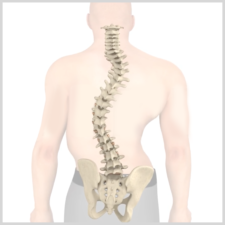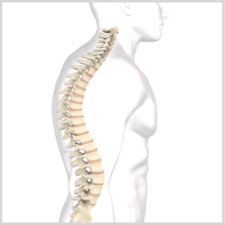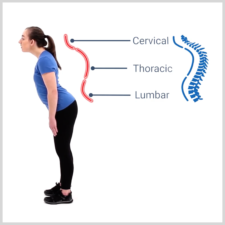Achieving Trunk Symmetry: 4 Common Challenges and Their Solutions

Proper wheelchair positioning is a must for your patients’ comfort and quality of life. When a person is improperly positioned, a number of problems can occur, particularly asymmetry of the spine, which leads to distortion of the ribcage.
The most common trunk positioning challenges in those who use wheelchairs are:
Understanding the causes of these challenges, watching out for signs that may indicate that a trunk positioning challenge is occurring, and knowing which interventions are appropriate for achieving symmetry will go a long way toward helping your patients who use wheelchairs remain healthy and comfortable.
Challenge #1: Scoliosis
Scoliosis is a lateral flexion of the trunk commonly seen in conjunction with pelvic obliquity. The curvature may be C-shaped or S-shaped. The S shape is often the result of the client attempting to right their head over an initial C-shaped curvature.
What Causes It?
Scoliosis may be caused by an imbalance of strength or muscle tone on either side of the spine. Decreased tone or strength can lead to postural collapse to one side or the other. Some clients assume this asymmetrical posture intentionally in an effort to feel stabilized or to achieve certain functional tasks.
How Should I Solve It?
Many off-the-shelf backs have a generic contour to encourage a midline position of the trunk. If this is insufficient, lateral trunk supports are required. Often these are curved to provide better contact with the rib cage. If more significant support is needed to reduce a scoliosis, the lateral supports may be placed asymmetrically in conjunction with lateral hip supports to provide three-point control of the curvature. In this intervention, one lateral is placed lower than the other, on the apex of the convex portion of the curve. If a flexible curvature cannot be reduced with a reasonable amount of lateral support, a molded system may be required to better distribute pressure and provide more intimate contact with the trunk. This intimate contact may also slow the progression of the curvature.
If the client has a fixed scoliosis, ensure that the client can balance their head over the trunk.
What Is the Goal?
Correcting a flexible scoliosis provides neutral alignment over the pelvis, while accommodating a fixed scoliosis distributes pressure over the trunk and levels the client’s head.
Challenge #2: Kyphosis
Kyphosis is forward flexion of the trunk. It can occur at various levels of the spine and may be combined with hyperextension of the neck.
What Causes It?
Kyphosis is often caused by osteoporosis in the geriatric population. In clients who require wheelchair seating, kyphosis may be due to flexion of the hips or thoracic area, postural collapse forward (especially in clients with low tone or weakness), posterior pelvic tilt, or the client intentionally assuming this position in an attempt to increase stability.
How Should I Solve It?
If the forward flexion is flexible, anterior trunk support is required. For the anterior trunk support to be effective, however, the posterior trunk also needs to be well supported. For example, sling seats and backs position the client in a posterior pelvic tilt and kyphosis, exacerbating the problem.
Anterior trunk supports include:
- Chest straps—keep the client from falling forward to the point where they are unable to resume an upright posture but do not promote trunk extension.
- Shoulder straps—promote trunk extension and scapular retraction, making them effective in reducing a flexible kyphosis.
- Vests—tend to provide the most support at the sternum, making them less effective for forward trunk flexion.
- Shoulder retractors—provide similar support to shoulder straps but are rigid.
If a kyphosis is fixed, the client may tend to look downward most of the time. In order to look up, breathe optimally, and swallow, the client must lift their head on top of the flexed trunk, resulting in a hyperextended neck.
To allow the client to maintain an upright head without hyperextension, two primary strategies are employed:
- We can open the seat-to-back angle to the point where the client’s head is above or just behind (posterior to) their pelvis.
- We can place the client in a tilt-in-space wheelchair and tilt the client to the point where their head is over or just behind the pelvis.
What Is the Goal?
If a kyphosis is flexible, correcting to anatomical alignment also aligns the head. In a fixed kyphosis, providing an upright and aligned head promotes vision, improves breathing, and increases safety in swallowing.
Challenge #3: Lordosis
Lordosis is a hyperextension of the lumbar area of the spine.
What Causes It?
If the client has tight hip flexors and these are overcorrected, as occurs when the thighs are moved downward in seating, the pelvis will be pulled into an anterior pelvic tilt, resulting in lordosis. Increased tone can also pull the pelvis into this posture. Some clients assume this position intentionally, and it is often seen in young men with Duchenne muscular dystrophy as they continue to lean forward in an attempt to balance their head.
How Should I Solve It?
If the lordotic position is flexible, provide both posterior and anterior support to the trunk, particularly the lower spine. Available hip flexion should be evaluated and the seat-to-back angle set in a way that respects any range limitations.
Anterior trunk support may reduce the lordosis. Anterior vests, which provide pressure over the sternum, can be helpful. Abdominal panels can be very effective in reducing a flexible lordosis.
If the asymmetry is fixed, a molded back is often required to provide adequate pressure distribution and support.
What Is the Goal?
If the lordosis is flexible, the goal is neutral alignment of the trunk over the pelvis and improved pressure distribution. If the lordosis is fixed, then our primary goal is improved pressure distribution.
Challenge #4: Rotation
What Is It?
Trunk rotation is a single or dual rotation of the vertebrae.
What Causes It?
Typically a component of pelvic rotation or lateral trunk flexion, trunk rotation is also seen as a component of certain reflexes, particularly the asymmetrical tonic neck reflex (ATNR).
How Should I Solve It?
In rotation, one side of the trunk pulls forward. Interventions are primarily anterior trunk supports to pull this side of the trunk back, such as shoulder straps.
If the rotation is fixed, the client and the seating system may need to be placed on the mobility base so that the client can face forward. Significant fixed rotation may also require a molded back to achieve adequate pressure distribution and support.
What Is the Goal?
As with other trunk asymmetries, our goal is neutral alignment of the trunk and correction of any pelvic rotation.
As an OT, your client’s quality of life is one of your highest priorities. Identifying seating challenges that can negatively impact their health and their comfort and then finding solutions will help your clients enjoy life to the fullest.




